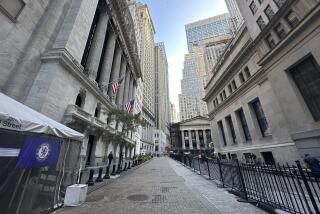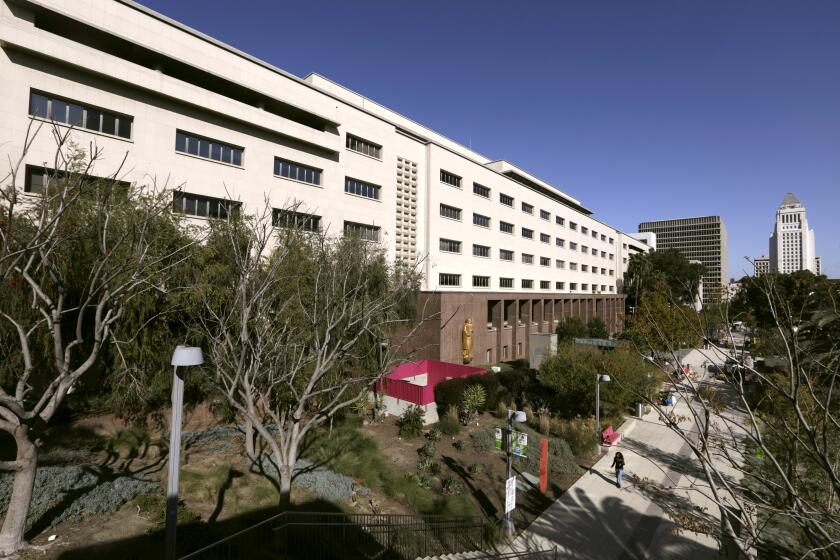A Rate Hike? Don’t Get Out the Black Armbands Yet
- Share via
In the category of “really important things to worry about,” the outcome of Tuesday’s Federal Reserve Board meeting must rank right up there with . . . what? Global warming? The threat of new, antibiotic-resistant microbes? The chance of a meteor obliterating Nebraska?
OK, we’re being flip. But for the amount of paper, ink and bytes already expended in the debate over what the Fed will or won’t do--raise interest rates a quarter-point or leave them alone--some people might think that the future of mankind was at stake.
However the Fed goes, we can say with some certainty that the world is unlikely to end just yet. And even for Wall Street, it will probably take something more significant than one more small interest rate hike to finally kill off the great 1990s bull market.
Like what? Well, there’s the problem. The big story of this decade, from investors’ point of view, is what hasn’t happened: Feared economic, political and market disasters either simply didn’t occur as predicted, or they occurred but quickly blew over.
Which explains a lot about how the bulls have been able to maintain control of the market for so long, and why the Dow Jones industrial average crossed 7,300 last week, a threefold gain from its bear-market low of 2,365 reached in October 1990.
Think back to the Persian Gulf War in January 1991. It had all the makings of a major conflagration, of course. Many investors naturally feared the worst--even World War III.
Instead, the West’s victory was decided in a matter of weeks. (Remember what was said about captured Iraqi rifles later put up for sale: “Never fired. Only dropped once.”)
Later in 1991, the Soviet Union dissolved. Civil war could easily have erupted on a broad scale, threatening world security. Instead, Russia slipped fitfully but mostly peacefully out of communism and into some tentative form of democracy.
In 1992 and ‘93, concern about Japan’s deep economic depression and devastated real estate and stock markets ran so high that bearish Wall Streeters began to fear that Japan would pull down the rest of the global economy.
It wasn’t a ridiculous notion. Japan was, after all, the world’s second-largest economy. Yet Japan’s pain has all along remained Japan’s pain--not something felt by the rest of the world.
How about the derivative-securities scare of 1994? Plenty of stories were written about the global spread of derivatives, those hybrid stock-, bond- and currency-based securities that allow big investors to make all sorts of market bets, or hedge all sorts of bets, in complex transactions that link the world’s major financial institutions.
*
Critics feared that one derivative-related blowup could topple banks, brokerages and even central banks like so many dominoes. But many derivative securities exploded in 1994 as global interest rates jumped--yet the financial system handled the problems with relative ease, and none of the doomsday scenarios played out.
(Orange County’s bankruptcy was one of the worst derivative-related debacles, and at the time--late 1994--the county’s financial collapse was expected to be a long-term depressant on the municipal bond market. That turned out to be no more true than the idea that Japan’s woes would drag down other world stock markets.)
Nor did the dollar’s spectacular plunge in the spring of 1995 trigger a torrent of selling of U.S. bonds and other assets by foreign investors, as some analysts predicted.
And does anybody even remember the grain price surge in the spring of 1996? Wheat, corn and soybean prices rocketed as the planting season in the Midwest got a late start. With the extremely low level of world grain stockpiles at the time, a poor U.S. crop could have set the stage for a leap in food prices worldwide--and perhaps a new inflationary spiral.
But the seeds got into the ground, and by fall of last year the United States was looking at bumper crops in key grains.
None of the above is meant to minimize the importance of these tests for investors and the global economy. Each test, in its time, seemed scary enough to permanently extinguish investors’ appetite for stocks or other financial assets.
And some of these events actually did trigger enough selling--albeit temporarily--to send U.S. stock and-or bond markets diving. But none of them proved to be a deathblow.
What we’ve seen in the 1990s, then, is that the down cycles for financial assets like stocks have been suitably scary but fairly short. The up cycles, in contrast, have generally been long, and quite enriching for investors who have stayed aboard for the ride.
That trend of short down cycles and long up cycles has, in fact, been pretty much the norm for the economy and stocks since World War II. Which makes sense, if you believe that peoples’ natural tendency, when unfettered by government, is to strive for more, overcome obstacles and generally move their society ahead. Life goes on, and for many people, it gets better.
*
There is always going to be something to worry about--some reason not to invest for the future, some reason to believe that the economy or stock market is headed into a prolonged Dark Age.
The chance of another quarter-point rate increase by the Fed at Tuesday’s policy meeting, however, hardly seems worthy of inclusion in that category of fears.
Maybe the simple reason for the markets’ (and media’s) obsession with small moves in interest rates is that, for now, investors really have so little else to worry about.
Try to imagine that it’s 10 years ago, and somebody is telling you that in 1997: The Cold War will be over and Russia and NATO will be working together, China will be capitalist in all but name; world trade will be booming, the U.S. unemployment rate will be at a 23-year low, welfare rolls will be tumbling, Democrats and Republicans will have worked out a deal to balance the federal budget, and baby boomers will be pouring retirement savings into stocks.
All of that, combined, forms the basis for why the U.S. market is so richly valued today.
Higher interest rates certainly would make investors question those rich stock valuations. But given the incredibly positive fundamentals still underlying the market, it will probably take a lot more than another modest rate hike or two to finally send the 1990s bull to the slaughterhouse.
More to Read
Inside the business of entertainment
The Wide Shot brings you news, analysis and insights on everything from streaming wars to production — and what it all means for the future.
You may occasionally receive promotional content from the Los Angeles Times.










